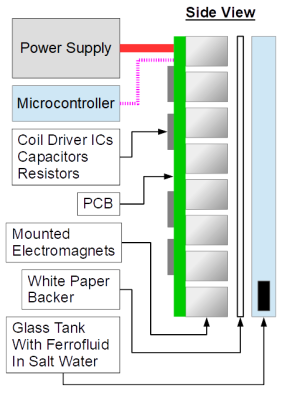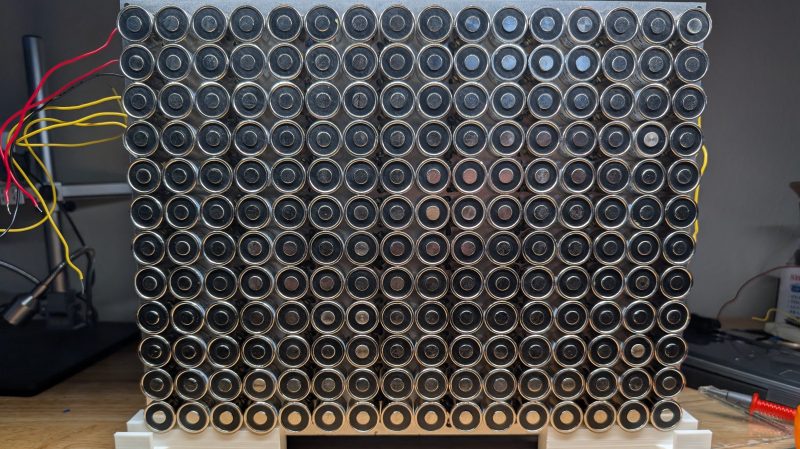Ferrofluid is fun. You’ve probably seen all kinds of demos with it bouncing around in response to magnetic fields, or dancing near a speaker. [beastie417] decided to turn the entertaining fluid into a display.

The concept is straightforward enough. First, construct a tank of ferrofluid with a white panel behind it for contrast. Then, place it in front of a grid of electromagnets. Now you have many “pixels” you can turn on and off. You turn a magnet on to attract ferrofluid to that point, and turn it off to let it fall away. Since the ferrofluid contrasts with the white background, you have a viable display!
[beastie417] notes that while the concept is simple, the execution is hard. Ferrofluid can be very difficult to work with, instantly staining many materials like acrylic and even glass that isn’t properly prepared. It can also be quite expensive to construct a display like this, with [beastie417] noting their 16×12 pixel design costing approximately $700 thus far. Then you have to figure out how to drive all the pixels—this project uses DRV8908 coil driver ICs running off a microcontroller which controls the display and handles animations.
We’ve seen some great ferrofluid displays before, like this neat build that could even create readable glyphs. Meanwhile, if you’re doing rad things with the coolest fluid of the new millennium, don’t hesitate to let us know!
















In addition to the hackaday.io link, you can see more pictures of the project here: https://www.instructables.com/Animated-Flat-Panel-Ferrofluid-Display-Using-Elect/
where is 1hz in this?
I don’t imagine this thing has sub second refresh rates…
Yeah, 1Hz display refresh is the challenge tie-in
I couldn’t get the video related to the feature project to play.
I did find the videos on the Applied Procrastination channel doing something close to this.
Build a small one with some ferrofuild eye candy:
https://www.youtube.com/watch?v=G15dPiCKPL0
A larger build with more ferrofuild display action:
https://youtu.be/5PFgVtzsXHM?t=37
I just posted these. This is very much a project still in development.
https://youtu.be/uhHSJSJDNuM
https://youtu.be/oA5lSi43jE0
Also, the Applied Procrastination channel was my original inspiration! If you read my full write-up I call this out numerous times.
Awesome! Thanks for the ferro candy.
Good luck with the project!
I am curious to see the power requirements of driving this display. Using magnets mounted on some kind of linear actuator might reduce the power draw, and potentially cost as well.
The power requirements are quite large though it depends on how many simultaneous dots are driven. A linear actuator or gantry could work but you are then limited to displaying a single dot and would be a very different kind of display. See the demo videos below
https://youtu.be/uhHSJSJDNuM
https://youtu.be/oA5lSi43jE0
I was thinking the suggestion was to have every magnet/pixel on a linear actuator, which moves the magnet closer or further away from the display/tank.
I used to work in an office that dealt in confidential customer information, which we had to have to verify customer identity, but had to shred if we put it on notes or any permanent media like printouts or scratch pads to assure non-disclosure of identifying information Often we would need to consult with other workers, which meant writing information down and hand carrying it to co-workers for review.
Eventually I got a Fisher Price version of the ferrofluid display, the Magnadoodle, to take notes. It was large, and temporary, it came with its own stylus on a string, and it came in delightfully friendly colors. It also pissed management off, and they never pushed the issue with me.
I have no idea if the one hertz would be enough to run a stylus on a plotter for creating an image on a ferrofluid display, but it was an idea I used to think about